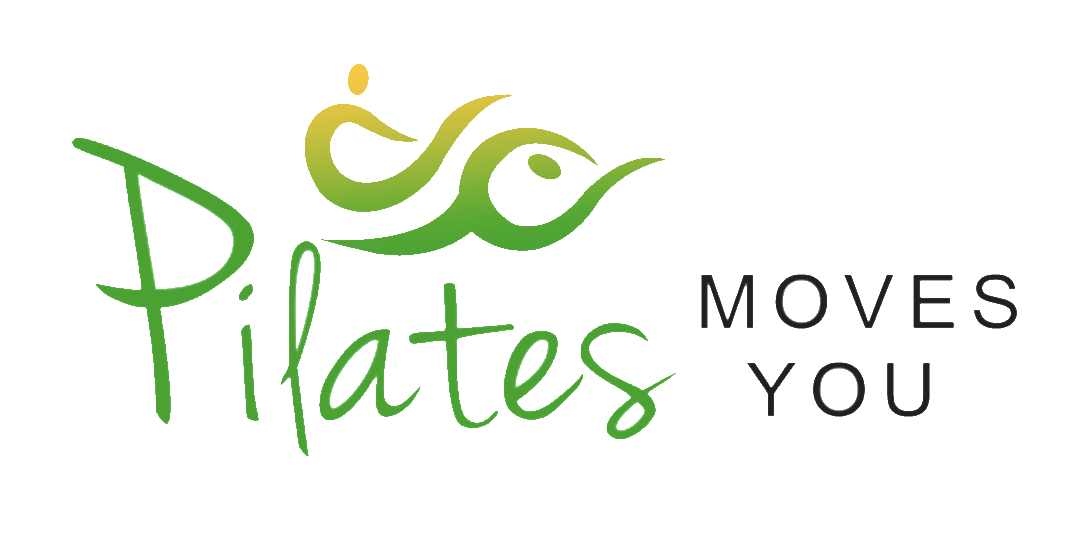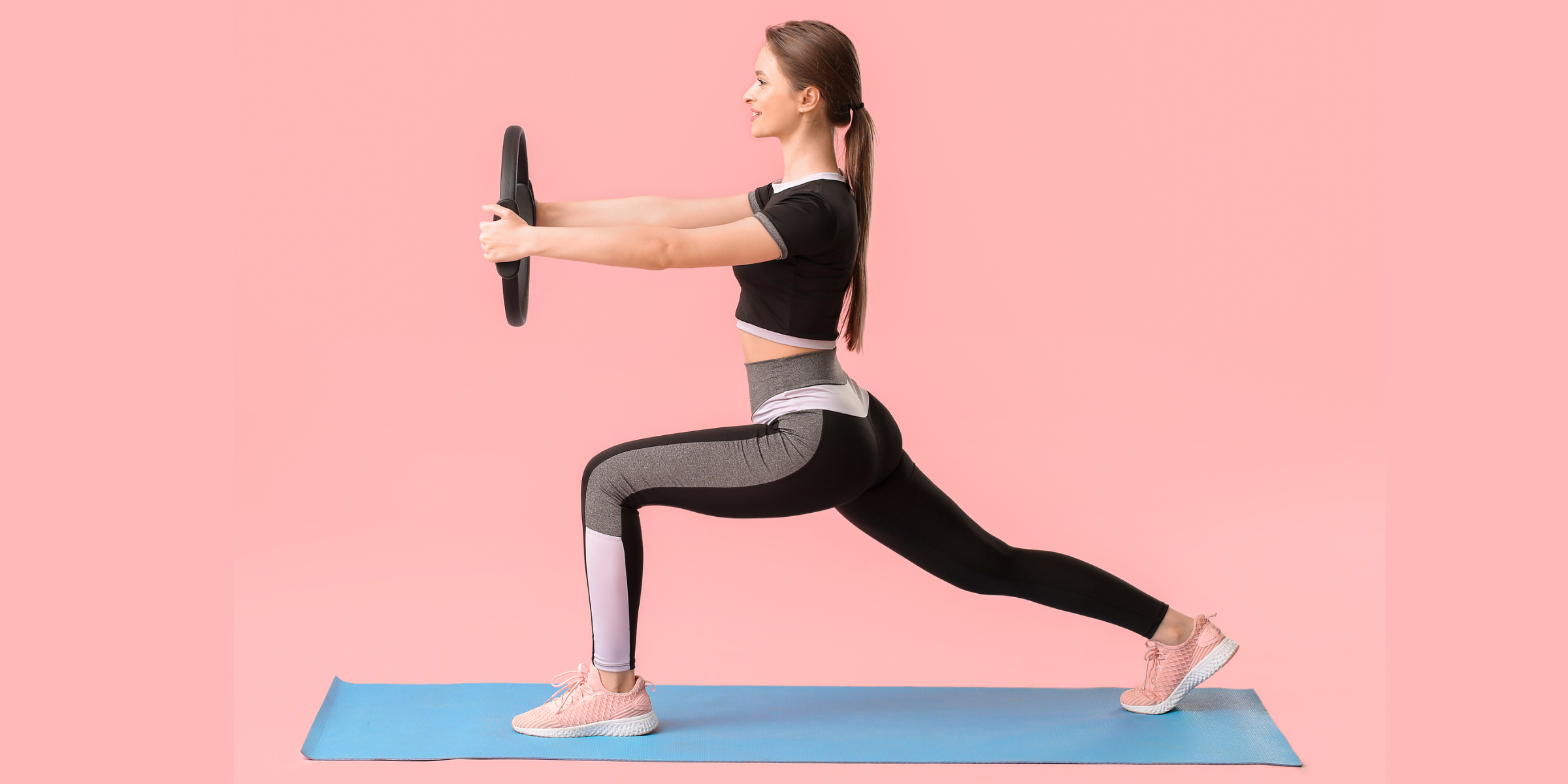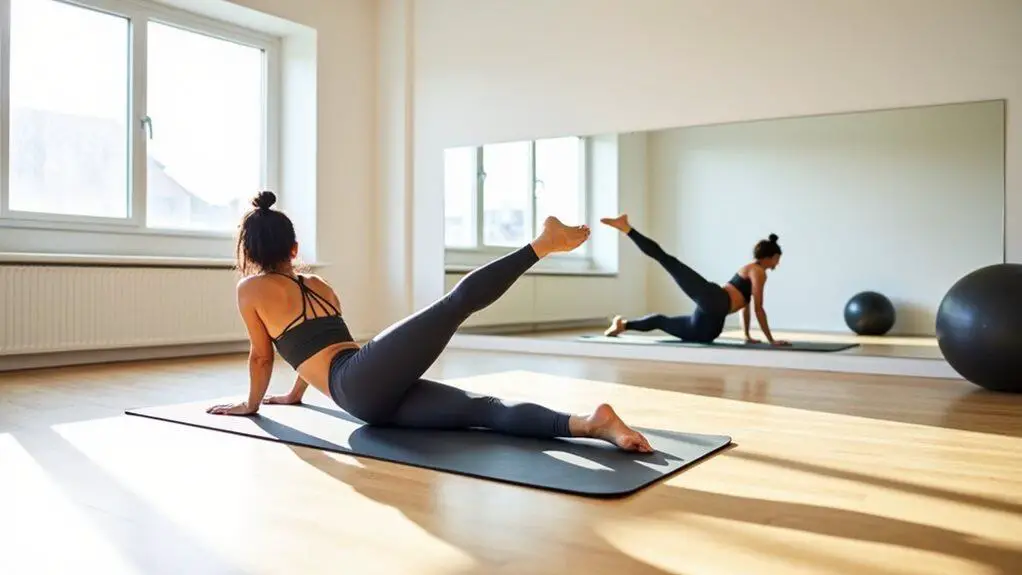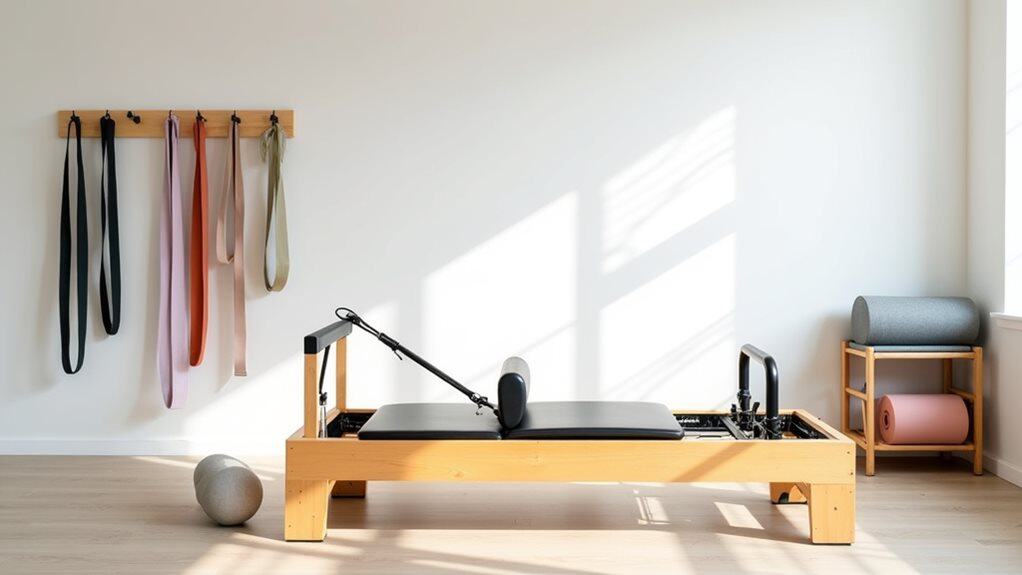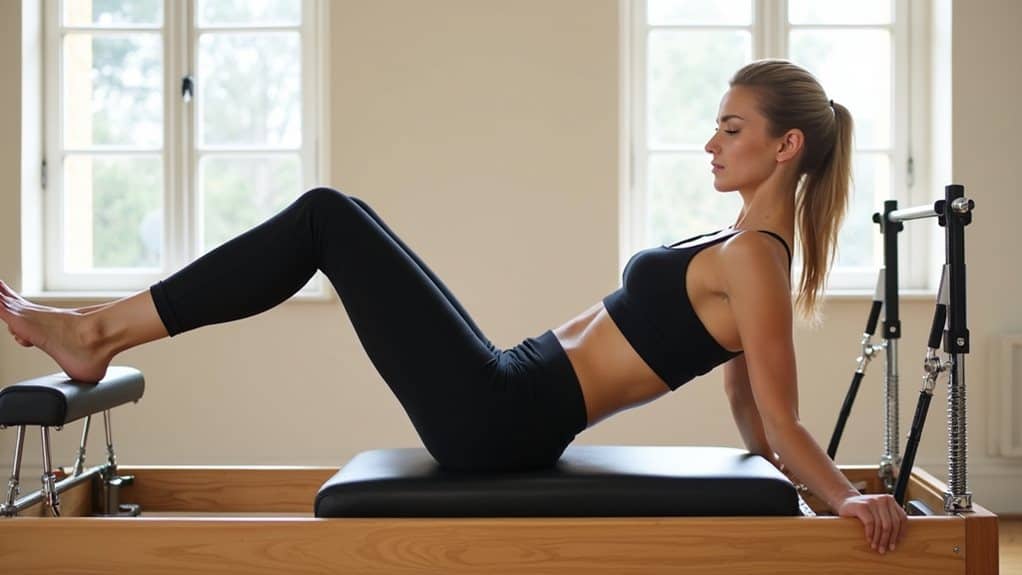Are you looking for a new way to build muscle and tone your body? Have you heard of the Pilates Ring? This small, lightweight piece of equipment can be a valuable addition to your workout routine.
The Pilates ring (also known as a magic circle or fitness circle) can help build muscle. The ring provides resistance for exercises that target specific muscle groups, such as the arms, legs, and core. It is a low-impact form of exercise that can help tone and strengthen muscles without placing too much stress on the joints.
In this article, we will explore the benefits of using the Pilates Ring for muscle building, how to incorporate it into your workouts, and what to expect in terms of results.
What is the Pilates Ring?
Get ready to learn about a unique piece of equipment that can enhance your workout routine! The Pilates ring, also known as a magic circle, is a small, circular piece of equipment that’s made of flexible metal or rubber.
It’s a versatile tool that can be incorporated into various exercises to help tone and strengthen your muscles. Pilates ring exercises are designed to target specific muscle groups, such as the arms, chest, back, and legs. These exercises can be done while standing, sitting, or lying down, and can be modified to suit your fitness level.
Some popular Pilates ring variations include the inner thigh squeeze, overhead press, and chest press. Incorporating the Pilates ring into your workout routine can help improve your strength, flexibility, and balance. It can also provide a low-impact workout that’s easy on your joints.
Using the Pilates ring has numerous benefits for your body. It can help improve your posture, increase your core strength, and tone your muscles. In addition, the Pilates ring is portable, lightweight, and easy to use, making it a convenient tool for anyone looking to improve their fitness.
So, if you’re looking for a new way to challenge yourself and take your workouts to the next level, give the Pilates ring a try! Get ready to incorporate it into your workout routine and see the results for yourself!
The Benefits of Using the Pilates Ring
So, you’re telling me that using a certain circular device can actually enhance your physique? Well, well, well, look who’s trying to cheat their way to a toned body. But I suppose it’s not cheating if it’s actually effective, right?
Let’s talk about the benefits of incorporating the Pilates Ring into your workout routine.
Firstly, the Pilates Ring is a versatile piece of equipment that provides resistance for a full-body workout. It can be used to tone and strengthen various muscle groups, including the arms, legs, and core. The Ring’s unique shape and design allow for a range of exercises that target specific areas of the body, making it an effective tool for achieving your fitness goals.
Moreover, using the Pilates Ring can enhance your overall fitness level by improving your posture, flexibility, and balance. The Ring’s resistance forces you to engage your core muscles, promoting better alignment and stability. Additionally, incorporating the Ring into your routine can help prevent injuries and alleviate chronic pain, making it a valuable addition to any workout regimen.
Incorporating the Pilates Ring into your workout can have numerous benefits, from toning and strengthening your muscles to improving your overall fitness level. So, if you’re looking for an effective and versatile tool to enhance your physique, consider giving the Pilates Ring a try.
Next, we’ll discuss how you can incorporate the Ring into your workout routine for maximum effectiveness.
Incorporating the Pilates Ring into Your Workout
Let’s talk about how you can spice up your workout routine by incorporating this versatile tool. The Pilates ring, also known as the magic circle, is a great addition to your fitness regimen. Not only does it help you engage your core muscles, but it can also add a level of resistance to your exercises.
Here are some creative variations you can try with the Pilates ring to switch up your workout routine:
-
Squats – Place the ring between your thighs and hold it in place as you perform traditional squats. This will engage your inner thighs and glutes, giving you a great lower body workout.
-
Arm exercises – Hold the ring with both hands and press it together while performing arm exercises like bicep curls or tricep extensions. This will add an extra level of resistance to your arm workout.
-
Lunges – Hold the ring with both hands and place it behind one knee as you perform lunges. This will add an extra level of resistance to your lower body workout, engaging your glutes and quads.
-
Ab exercises – Place the ring between your ankles and perform traditional ab exercises like crunches or leg lifts. This will engage your core muscles even more, giving you a great ab workout.
When incorporating the pilates ring into your workout, you can adjust the resistance level by using a heavier or lighter ring. This will allow you to challenge yourself as you progress in your fitness journey. Get creative with your exercises and try different variations to keep your workout fun and engaging.
As you start incorporating the pilates ring into your workout routine, you may wonder how to target specific muscle groups. In the next section, we’ll talk about using the pilates ring for specific muscle groups.
Using the Pilates Ring for Specific Muscle Groups
We’re going to focus on targeting specific areas of our body using the Pilates ring, giving us a chance to zero in on our trouble spots and work towards achieving our fitness goals with a little extra oomph.
Pilates ring exercises are great for muscle activation and targeted toning. For example, using the ring to squeeze between your thighs while doing squats can help activate the glutes and inner thighs for a more toned lower body.
Another great exercise is the Pilates ring push-up. By placing the ring between your hands and pushing against it while doing push-ups, you can target the chest and triceps for a more defined upper body.
You can also use the ring to add resistance to traditional Pilates moves like the hundreds or the bridge, making them even more challenging and effective.
Incorporating the Pilates ring into your workout can help you achieve your fitness goals by allowing you to target specific muscle groups with precision. Just remember to keep proper form and technique to avoid injury and get the most out of your workout.
Keep reading for tips on how to do just that.
Tips for Proper Form and Technique
Achieving your fitness goals with precision requires proper form and technique, and these tips will help you avoid injuries and maximize your workout when using the Pilates ring.
One common mistake is gripping the ring too tightly, which can cause tension in your arms and shoulders instead of engaging your core muscles. To avoid this, hold the ring lightly and focus on squeezing your inner thighs and glutes while maintaining a neutral spine.
Another tip is to use the recommended resistance level for your fitness level. If the ring is too easy to squeeze, you won’t challenge your muscles enough, and if it’s too difficult, you risk injury. Start with a moderate resistance level and gradually increase as you get stronger.
Remember to breathe deeply and engage your core muscles throughout each exercise. Proper form and technique are crucial for building muscle with the Pilates ring.
By avoiding common mistakes and using the recommended resistance level, you can safely and effectively build strength and tone your muscles with this versatile piece of equipment.
Now, let’s explore how the Pilates ring compares to other muscle-building methods.
How the Pilates Ring Compares to Other Muscle-Building Methods
Comparing the Pilates ring to other methods of muscle-building can help you determine which approach is best suited to help you achieve your fitness goals.
When it comes to free weights vs Pilates ring, the former is a more traditional and straightforward approach to building muscle. Free weights allow you to add more weight as you get stronger, which can lead to faster muscle growth. On the other hand, the Pilates ring provides resistance that is more targeted and focused on specific muscle groups. This can be beneficial for those who want to tone and sculpt specific areas of the body.
Another popular method of muscle-building is using resistance bands. When comparing Pilates ring vs resistance bands, both methods offer similar benefits. They both provide resistance that can lead to muscle growth and toning. However, the Pilates ring offers more versatility in terms of the types of exercises you can perform. It can be used for both upper and lower body workouts, while resistance bands are typically used for upper body exercises only.
Ultimately, the choice between free weights, resistance bands, and the Pilates ring will depend on your personal fitness goals and preferences. Each method has its own unique benefits and drawbacks. It’s important to experiment with different methods and find the one that works best for you. With that being said, understanding the differences between these methods can help you make an informed decision about which approach to take for your muscle-building journey.
As you continue to explore the potential benefits of the Pilates ring, it’s important to have realistic expectations for muscle building. While the Pilates ring can help you tone and sculpt your muscles, it may not be the most effective method for building significant muscle mass. However, when used in combination with other muscle-building methods, the Pilates ring can be a valuable addition to your fitness routine.
Realistic Expectations for Muscle Building with the Pilates Ring
You can have realistic expectations for toning and sculpting your body with the Pilates ring, but it may not be the most effective method for significant muscle growth. While the Pilates ring can provide some resistance and challenge to your muscles, it isn’t designed to be a heavy weightlifting tool.
Therefore, if you’re looking to bulk up and significantly increase your muscle mass, you may need to incorporate other forms of strength training into your routine. However, if your goal is to improve your overall fitness, flexibility, and muscle tone, the Pilates ring can be a great addition to your workout routine.
It can help you target specific muscle groups, such as your abs, glutes, and inner thighs, and provide a low-impact workout that’s easy on your joints. Additionally, using the Pilates ring can help improve your posture and alignment, which can lead to a more toned and sculpted appearance.
In conclusion, while the Pilates ring may not be the most effective tool for significant muscle growth, it can still be a valuable addition to your workout routine for toning and sculpting your body. It’s important to have realistic expectations for what the Pilates ring can do for your muscle growth potential and to incorporate other forms of strength training if your goal is to bulk up. However, if you’re looking for a low-impact, targeted workout that can improve your overall fitness and muscle tone, the Pilates ring may be just what you need.
Conclusion and Final Thoughts
By incorporating the Pilates ring into your routine, you can improve your overall fitness and sculpt your body in a targeted and low-impact way. While it may not be the most effective tool for building large amounts of muscle mass, the Pilates ring can certainly help to tone and strengthen your muscles.
The ring can be used to engage muscles that are often overlooked in other workouts, such as the inner thighs, hips, and arms. When it comes to muscle building potential, the Pilates ring may not be the first tool that comes to mind. However, it can still be a valuable addition to your fitness routine.
By using the ring to target specific muscle groups and incorporating resistance training, you can see improvements in muscle tone and definition over time. Additionally, the Pilates ring can be a great tool for those who are recovering from injuries or looking for a low-impact workout option.
In conclusion, while the Pilates ring may not be the most effective tool for building large amounts of muscle, it can still be a valuable addition to your fitness routine. By using the ring to target specific muscle groups and incorporating resistance training, you can see improvements in muscle tone and definition.
Additionally, the low-impact nature of the ring makes it a great option for those who are looking for a workout that is easy on the joints.
Now that you have a better understanding of what the Pilates Ring is, its benefits, and how to use it to target specific muscle groups, it’s time to put your knowledge into action.
Using the Pilates Ring is a great way to add variety to your workout routine and build muscle. However, like any muscle-building method, it’s important to have realistic expectations and understand that results take time.
Think of the Pilates Ring as a tool in your fitness toolbox, rather than a magic wand that will instantly transform your body.
So, grab your Pilates Ring and get ready to challenge your muscles in new ways. With proper form and technique, you’ll soon be on your way to building strength and tone.
Remember, building muscle is a process, but with consistency and dedication, you’ll see results. Keep pushing yourself, and don’t forget to have fun along the way!
